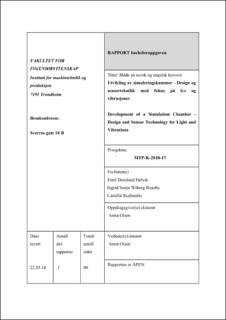| dc.contributor.advisor | Olsen, Anna | |
| dc.contributor.author | Helvik, Emil Døssland | |
| dc.contributor.author | Huseby, Ingrid Sonja Wiborg | |
| dc.contributor.author | Skalmerås, Camilla | |
| dc.date.accessioned | 2020-08-06T09:48:53Z | |
| dc.date.available | 2020-08-06T09:48:53Z | |
| dc.date.issued | 2018 | |
| dc.identifier.uri | https://hdl.handle.net/11250/2671058 | |
| dc.description.abstract | Denne oppgaven handler om utvikling og design av et simuleringskammer, med hovedfokus på påvirkningene lys og vibrasjoner har på kjølevarer. Gruppen har også skrevet om isolasjons- og materialvalg. Gruppen har samarbeidet med en annen bachelorgruppe, som skal se på blant annet design og temperaturregulering.
Sammen med den andre bachelorgruppen ble det lagt fram forskjellige faktorer som var relevante for oppgaven, og disse faktorene ble fordelt mellom de to gruppene. For denne oppgaven fikk gruppen faktorene lys, vibrasjoner, og valg av styringselement, isolasjon og materiale. Denne oppgaven danner en del av det teoretiske grunnlaget en trenger for å bygge simuleringskammeret.
Ved valg av problemstilling, fant gruppen ut at det å fremstille et nytt simuleringskammer, er interessant, da forskning på matholdbarhet er relevant i dagens samfunn. Først ble det laget en generell problemstilling, som var ‘’simulering av kjølevarer fra produsent til forbruker ved hjelp av et simuleringskammer’’. Den ble senere mer spisset og lyder ‘’Utvikling av et simuleringskammer, med fokus på lys, vibrasjoner, styringssystem, isolasjon og materialvalg’’.
For å finne ut det beste valget for de forskjellige faktorene, har gruppen sammenlignet to eller flere muligheter for hver av faktorene opp mot hverandre. Denne prosessen hjalp til med å få valgt den beste muligheten for simuleringskammeret. I alle delene er det først skrevet kort om temaet og avgrensninger, før det er blitt skrevet teori om aktuelle løsninger. Til slutt ble det diskutert og konkludert med hvilken løsning som vil egne seg best til simuleringskammeret.
Begge styringselementene som ble sett på, PLS og Arduino, er egnet til å brukes i kammeret. Lyset som ble valgt ut er av typen LED, stiftspære med sokkelen G9. Motoren som skal benyttes til å produsere vibrasjoner er en ERM-motor. Isolasjonsmetoden som anbefales av gruppen er plateisolasjon av typen stivt polyuretan. Til slutt er stål, helst rustfritt, det materialet som er valgt til å bygge selve simuleringskammeret. | en_US |
| dc.description.abstract | Abstract:
This bachelor’s thesis is about the development and designing of a simulation chamber, focusing on the effects that light and vibrations has on cooled goods. The group has also written about the choice of insulation and material.
The group has been co-operating with another bachelor group throughout the whole dissertation. The other group has, among other things, been writing about temperature.
Different relevant factors for the thesis was found and split between the two groups. The group writing this thesis got the factors light, vibrations, and choice of controlling method, insulation and material assigned. This thesis is a part of the theoretical foundation you need to build the simulation chamber.
When choosing topic, the group figured that developing a new simulation chamber was interesting, because research on food shelf life is relevant in the society today. Firstly, a general topic was made, which was ‘’Simulation of cooled goods, from producer to consumer, with the help of a simulation chamber’’. It was later refined to ‘’Development of a simulation chamber, focusing on light, vibrations, a controlling system, insulation and material’’.
To find the best choice for the different factors, the group compared two or more possibilities for each of the factors against each other. This process enabled the group to choose the best possibility for the chamber. In each chapter, the group writes about the different factors, and then theory about the possible solutions are presented. Lastly, the solutions are discussed, and the best solution for the chamber is chosen.
Both controlling systems the thesis has reviewed, PLC and Arduino, is possible to use in the chamber. The light that was chosen is an LED pin bulb with the G9 socket. The motor used to make the vibrations is an ERM motor. The insulation method recommended by the group is stiff polyurethane. Lastly, the material chosen for the chamber is steel, preferably stainless steel. | en_US |
| dc.language.iso | nob | en_US |
| dc.publisher | NTNU | en_US |
| dc.subject | Bachelor ingeniør maskin | en_US |
| dc.title | Utvikling av simuleringskammer - Design og sensorteknikk med fokus på lys og vibrasjoner | en_US |
| dc.type | Bachelor thesis | en_US |
